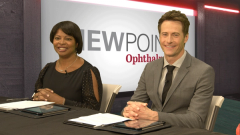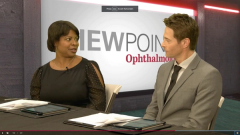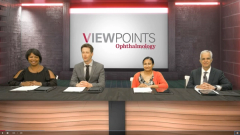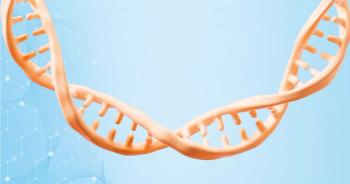
Use of Intraocular Steroids in DME
Retina experts discuss the benefits of using intraocular steroids to treat patients with DME as well as their approach to switching to steroids after a poor response to anti-VEGF therapy.
Episodes in this series

Nathan Steinle, MD: We’ve talked a bit about how the DME [diabetic macular edema] population is an interesting population. They’re working age. We also talked about this PTI [personalized treatment interval] arm, or treat and extend arm. In the real world, Dr Scott, how do you apply these clinical data from the YOSEMITE and RHINE trials to your patient population in Baltimore?
Adrienne Scott, MD: I do use this treat and extend strategy quite a bit. To me what that means, and again, I try to explain it so a patient can understand it. You come in, there’s no fluid in the picture, your vision is stable, the OCT [optical coherence tomography] shows no fluid. Then we extend and that means to me 1- or 2-weeks additional frequency.
Nathan Steinle, MD: How about this question? We’ve talked about anti-VEGF therapy. There’s also a whole other paradigm of steroids. I’ll throw it back to you. When do you switch to steroids, and how do you incorporate steroids into your treatment for DME?
Adrienne Scott, MD: I’ve become a believer in steroids, that some patients are more steroid-responsive with their DME. As was mentioned earlier, it’s a very complex pathophysiology about why some people get DME and how significant their DME is. For me, I tend to ascribe to the swim lane rationale, meaning that I’ll do an anti-VEGF first line, and after the first 3 anti-VEGFs I’m looking, and even after the first 1 or 2, if I don’t see significant improvement in their intraretinal fluid, certainly subretinal fluid should respond. But if I’m not seeing as much of a decrease in their central subfield on OCT, I’m starting to think and maybe even have the discussion about switching agents.
So perhaps after the first 3 anti-VEGFs, which are my first line of go-tos, I’ll consider using a steroid. Of course, you want to consider is that person going to be a good candidate? Do you have considerations about cataracts or elevated intraocular pressure [IOP], which I have become a bit more comfortable treating and managing those things, and being able to figure out the patients in whom they will be an issue. But I would go to steroids a lot earlier in my treatment armamentarium than I used to.
Nathan Steinle, MD: Interesting. How about this side of the table?
Prethy Rao, MD, MPH: Initially I was fearful of steroids because of that possible pressure spike. It’s interesting, you talk to our glaucoma colleagues, and they are like, “Yes, just go ahead and inject. We’ll take care of it.” I feel like I’m similar to Dr Scott in that I’ve been a bit more liberal with steroids. I would say I do try a couple of different anti-VEGF agents first before I do end up switching to the steroid. But I agree with Dr Scott in terms of it’s a very complex process, and so to be able to have that massive anti-inflammatory component really helps in these patients.
Nathan Steinle, MD: Dr Regillo?
Carl Regillo, MD, FACS, FASRS: I also utilize intraocular steroids in DME. It’s proven to work, we’ve had that experience. In fact, our use of intraocular steroids for DME predates the anti-VEGF era, and studies have validated its use. Of course, with that benefit comes the adverse effects of intraocular pressure elevation in some proportion of our patients, depending on the product and the dose, and cataract progression is almost inevitable, especially with repeated dosing. I use it as the second line, exactly as described, and I think virtually everyone does. But the timeline might vary a bit in terms of when we think about switching. I certainly always try to get the patient to the best drying anti-VEGF drugs, give those a chance first, because of lack of adverse effects and so forth. If I’m using aflibercept or faricimab, the better-drying drugs in DME, and I’m not seeing a good benefit after several injections, I will then think about switching to an intraocular steroid.
Often, as Adrienne said, it does help. So, in patients who are inadequate or suboptimal responders to anti-VEGF, or patients who need anti-VEGF very frequently, sometimes there’s the added benefit of durability. You get about 3 months out of an intraocular steroid, whether that’s the dexamethasone implant or triamcinolone off-label. That is also a potential benefit for patients if you want a durability play to help ease the burden. But the reality is that the burden doesn’t necessarily get reduced all that much because you bring them back to get their pressure checks and so forth. The one big difference between DME and wet AMD [age-related macular degeneration] is that we do have another effective therapeutic. Then you could even throw in laser once in a while, though I have to say, I can count on 1 hand how many focal lasers for DME I’ve done in the recent past. It’s a pretty rare bird now.
Adrienne Scott, MD: The other benefit of using a longer-acting steroid in patients with DME is, I feel like if you’ve given a long-acting steroid, for example, a dexamethasone implant, and you bring the patient back in 1 month to check their IOP, I think it’s been shown that the people who do have an elevated IOP response will declare themselves pretty early. If they pretty much do not, then they typically will not throughout the duration of therapy. So again, I think we can figure out those individuals who would benefit from the longer-acting steroid, decreased treatment burden, little risk of glaucoma, [and] little risk of prior steroid-related IOP elevation.
Carl Regillo, MD, FACS, FASRS: Nathan, one other point I’d like to make is that we talked about neovascular AMD being a lifelong treatment process. However, that’s another big difference between wet AMD and DME. The DRCR [Diabetic Retinopathy Clinical Research] Network studies were the first to show, because they used a PRN as needed-like approach to treating DME, that each and every passing year, the annual treatment average was going way down. It dropped quite a bit. In fact, as Protocol I got into years 3 and 4, the mean number of treatments in our patients with DME was down to 0, or 1, and so forth, which meant that some patients needed ongoing treatment. Not everyone was able to come off treatment. But there were many patients who after a year or two of anti-VEGF therapy on a relatively frequent and regular basis could eventually come off.
So, in practice, I do deviate from the treat and extend approach in that I’ll utilize it to some degree, but I will test the waters and stop treatment. Therefore I go from regular frequent treatment, maybe a little treat and extend, and then transition to PRN to see if they can go without treatment. I think a lot of that is, you’re doing a lot of anti-VEGF therapy over the course of 6 or 12 months. You’re getting that added benefit of reducing the level of diabetic retinopathy [DR]. As the level of diabetic retinopathy goes down, they’re less likely to have DME and other vision-threatening complications. So, resetting the thermostat on the level of DR, and that may not be permanent, of course, you may still need ongoing anti-VEGF therapy to achieve the improved level of DR. But that is an added benefit. Sometimes I’ll keep a patient on anti-VEGF longer if they have a very high level of DR, like severe NPDR [nonproliferative diabetic retinopathy] or early PDR [proliferative diabetic retinopathy].
Adrienne Scott, MD: This is another area in which we can maybe now give our patients some more data. To turn it back to one of the original questions, what do you tell a patient about how many treatments will you require? I think we can look at the DRCR, for example, Protocol I, and you can say, maybe the first year you’ll get 6 or 7 injections, but then the second year there’ll be even less. Then by the years 3, 4, and 5, to your point, Dr Regillo, maybe 1 or 2 injections.
Transcript edited for clarity
Newsletter
Keep your retina practice on the forefront—subscribe for expert analysis and emerging trends in retinal disease management.














































